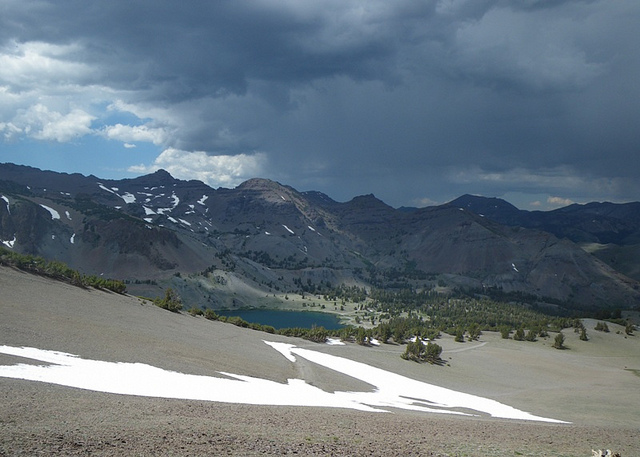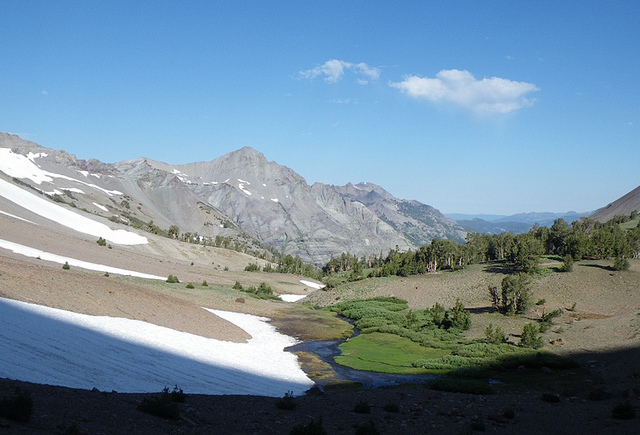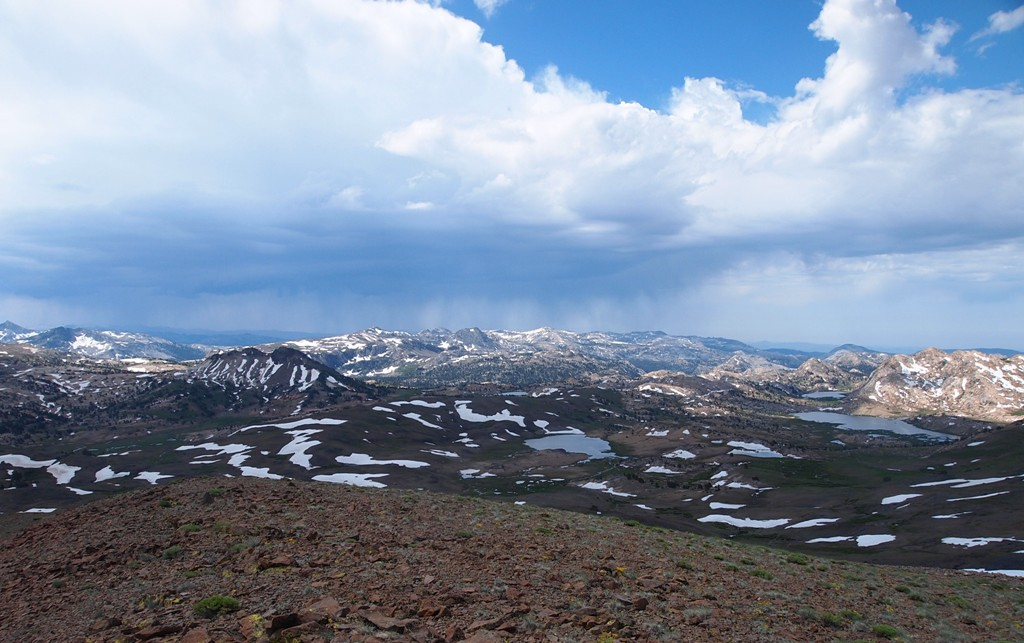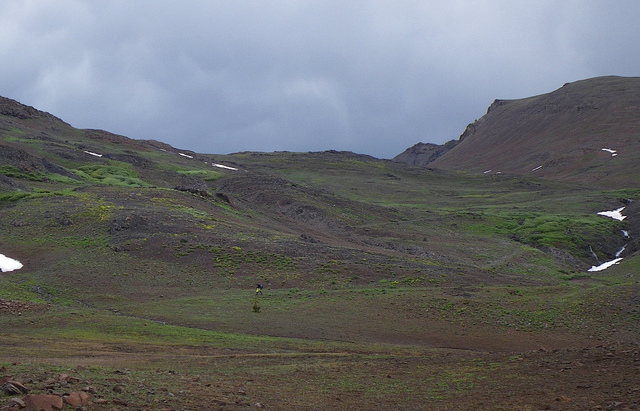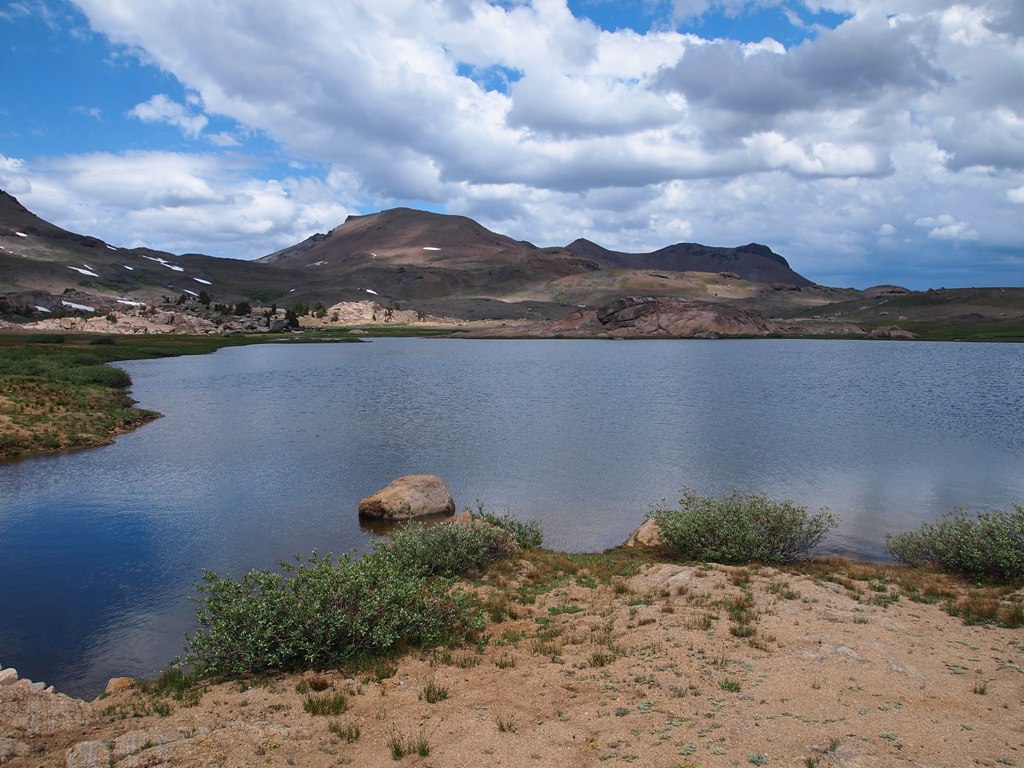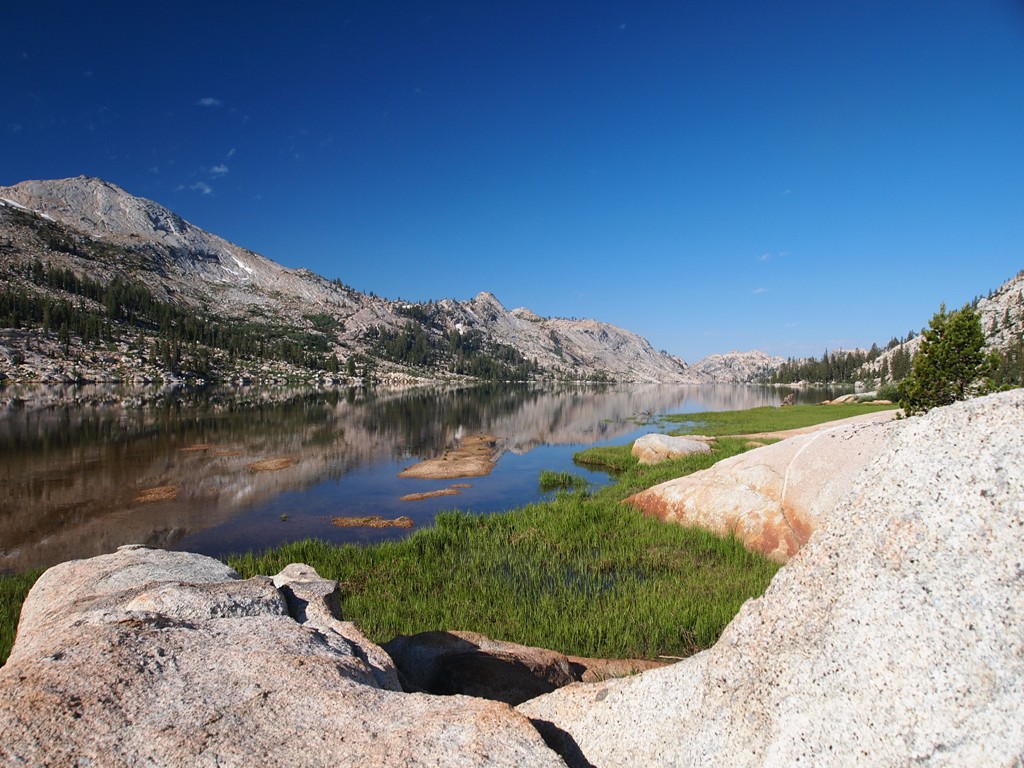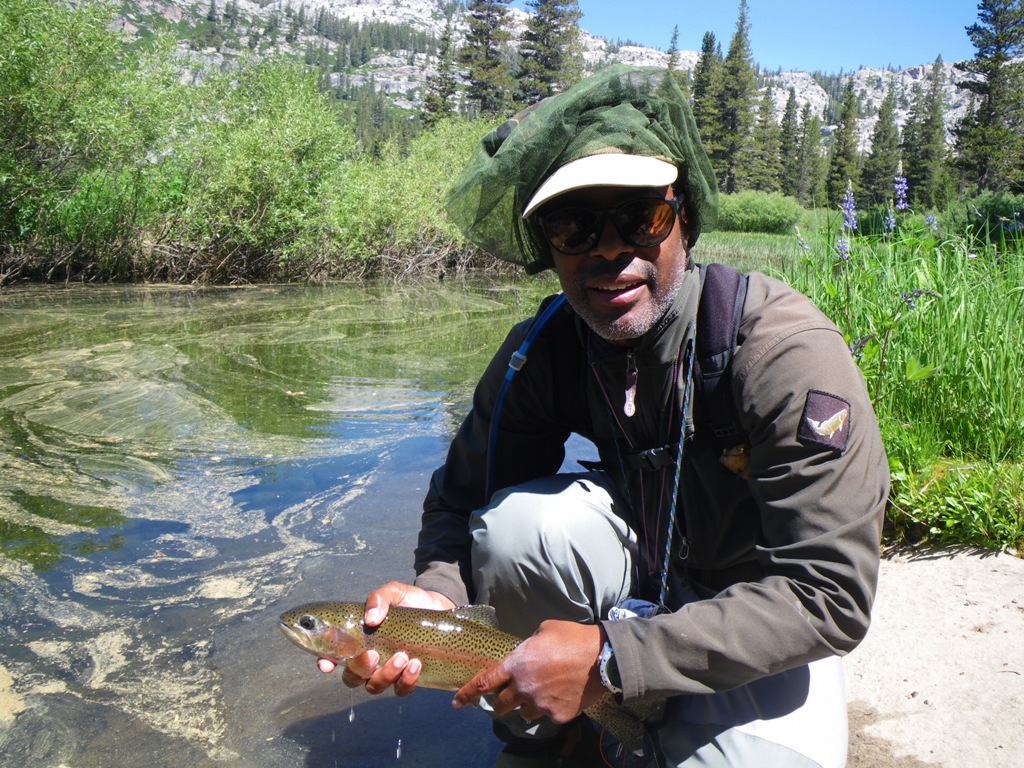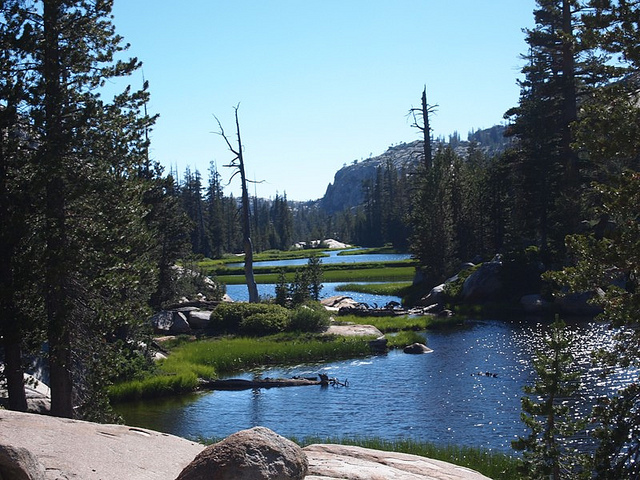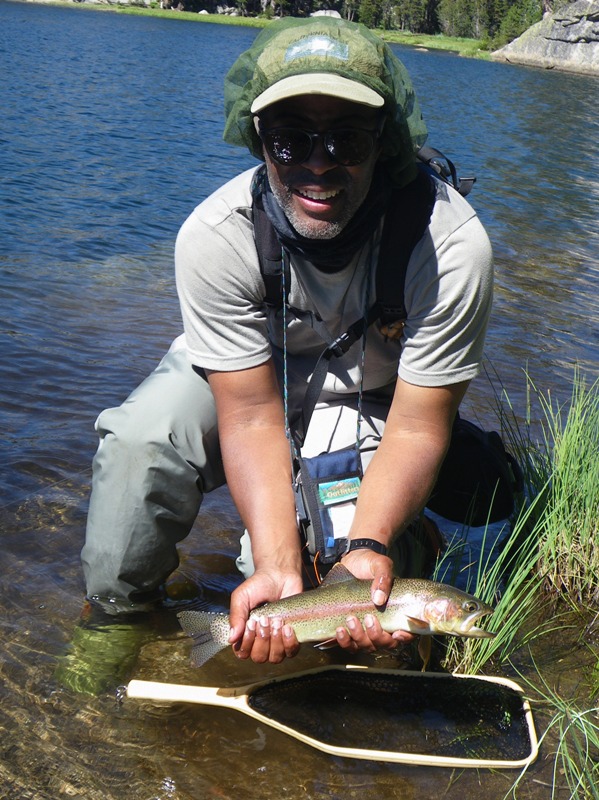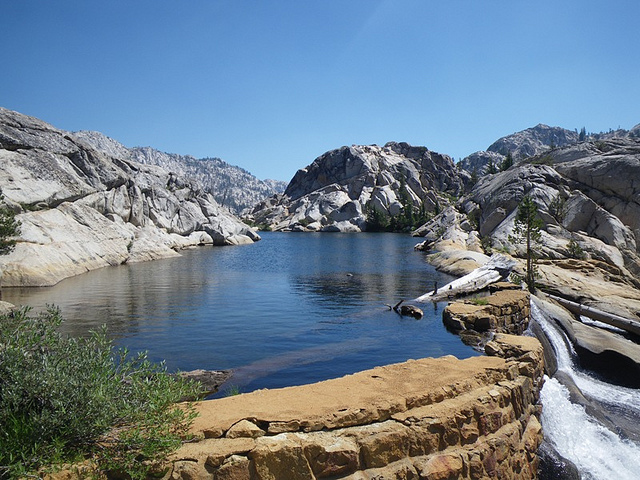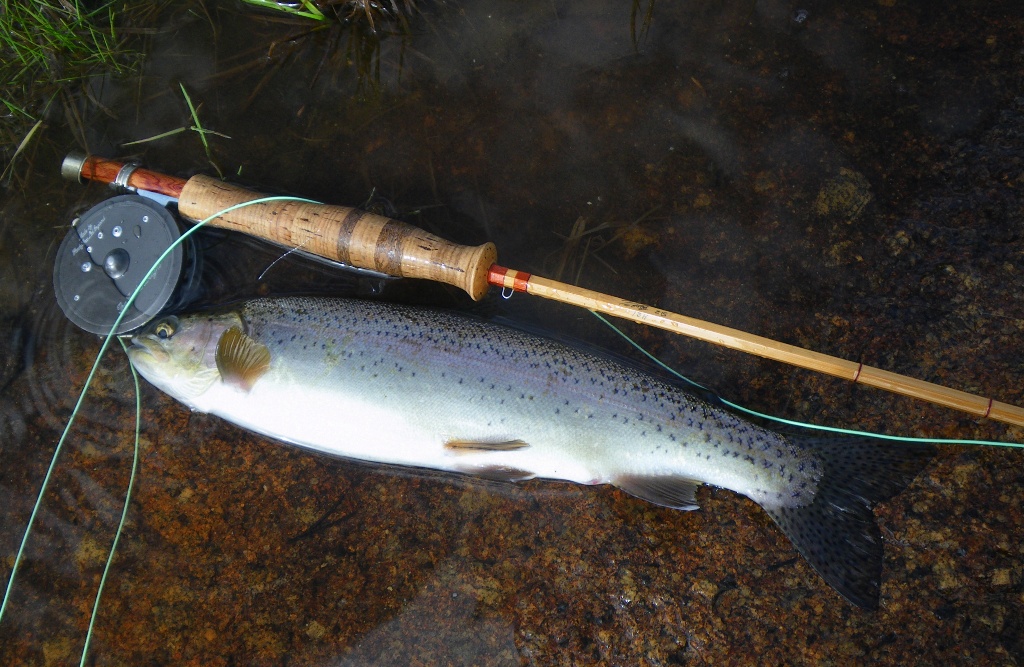|
|
|
|
|
Weather: Thunderstorms in the high basin, Clear and Cool
in the lower basin Sunday wasn’t the most frightening day I’ve spent in the Sierra but it probably should have been. It might have been had I not been caught in a thunderstorm before but I had and even though the severity of this storm and this situation was worse than I had ever encountered. I was determined, not frightened, determined that Roger and I were going to get down the mountain and be safe. The weekend started benignly enough, Roger I met at the Kennedy Meadows campground on Saturday for a week of backpacking and fishing in the Emigrant Wilderness. We’d planned a loop of sorts, Leavitt Lake, over to High Emigrant Lake, down to Emigrant Lake, over to Huckleberry, around to Cow Meadow Lake and back to Emigrant, exiting via Mosquito Pass and Kennedy Meadows.
The road to the Leavitt Lake was closed, adding 3.5 miles to our planned on Saturday and putting us on top of the first ridge at around 3pm, prime thunder time. We were about 300 feet from the first of two passes we planned to travel over on Saturday when the first lightening bolt lit up the sky. Roger was already on the ridge so we decided to go over and down instead of turning back. While he waited for me to join him on the crest, Roger counted the duration between seeing the flash of lightning and hearing the crack of thunder. The storm was several miles away and from the crest we could see the lighting stretching down to earth and back again. We made a plan to descend as quickly as possible to the saddle between the ridge we had crested and the next ridge beyond which lay our original day one destination of High Emigrant Lake. The saddle held the headwater springs of Kennedy Creek and a small grove of trees among which we could take shelter. We sheltered, Roger sitting on his plastic bear canister and me squatting on my foam sleeping pad, for several hours. When the store finally seemed to pass, it was too late for us to make the 3 hour trek over the next pass before dark. We camped for the night.
We found a small clearing on the down slope side of the saddle, opposite of where the storm had raged and within in a short distance from our sheltering area. It was pleasant, with just enough wind to keep the few mosquitoes at bay and enough trees to protect us from storm winds. There was no water in our immediate area but we had enough to last the night. With the abundance of bear and coyote scat nearby, we suspected we were in for an interesting night. In the wee hours of the morning, the store returned- first, in the form of wind and finally in the form of lightning. I waited to see 3 flashes of lighting before waking Roger. The storm was 6 miles away and I thought we should leave our tents and shelter again. A little over precautious perhaps but neither of us wanted to tell the other’s family that one of us had fried while sleeping in our aluminum poled tents. Fortunately the storm pass quickly and we were back in tent city within the hour. We’d spent a warm night and awoke to the sounds of barking and howling coyotes. That morning we were all business. We wanted to be over the next pass and at our destination lake before the afternoon thunderstorms rolled in. Thunderstorms usually arrive between 3pm and 4pm in the afternoon in the Sierra, more than enough time for us to make it over the pass and beyond. From the security of our small grove of trees the trail climbed and up and over the ridge in a series of switchbacks. Sections of the trail were still covered with snow and the steep terrain made for slow going as we navigated these sections- assessing the danger and deciding whether to slosh through or go around. The switchbacks shortened as we reached the top and when a fellow coming the opposite way declared the weather “excellent” on the other side, I was hopeful our storm experience was behind us. We reached the crest at about 11:00am and were treated to what I would consider less than “excellent” weather. Dark storm clouds were moving in but this wasn’t too unusual, especially given the forecast. It was late morning and experience has told both of us that the storm clouds shouldn’t become a concern for several more hours. We were perched above High Emigrant lake and the view was one that I had been waiting to experience for several years. The summit ranger station has a picture hanging on the wall of the entire Emigrant basin as seen from high above High Emigrant Lake. I’d hoped that this would be that view and I wasn’t disappointed. You can see High Emigrant Lake, Emigrant Meadow and Emigrant Meadow Lake, Middle Emigrant Lake and if you squint, maybe Emigrant Lake. I planned the trip in part to experience this for first hand. What the picture doesn’t capture is the views one also sees of Grizzly Peak, Emigrant Pass, Yosemite, the Saurian Crest, the lists goes on and on. It was amazing and Roger and I took our time snapping pictures and enjoying the views as we slowly descended toward High Emigrant. I think it was a clap of thunder that signaled to me that the late morning clouds had become angry. I can remember that I had already short cut the a first switchback on the trail when the sky opened up in earnest- a second crack of thunder and suddenly pea sized hail rained down. I stopped to put on my rain jacket just when the gale force winds whipped up. The thunder was exploding directly over head. It was 11:30am and we were at ground zero of a very bad storm. Worse yet, we were high on the mountain, exposed and unprotected. I watched the trail above me for Roger as I swung my pack on to my shoulders. Roger came into view and stopped just up the trail from me to put his poncho on. I anxiously watched as he tried to put his poncho over his head. The wind was whipping it around like a damaged kite and when I ran up to him to help, he shouted “Forget it! We need to get out of here!” Truer words were never spoken. I bolted. I outweigh Roger by about 40 pounds and with my heavier pack was able to descend faster. I took the lead. The mountain was nothing but rubble, no tries, no shrubs just talus. I’m surprised we didn’t feel the lighting coursing through the rock as it hit nearby. I don’t usually play the eco-terrorist but I short cut the trail where it was safe to do so, hoping that Roger would follow. I was so concentrated on getting down, that I didn’t notice the lightening flashing around us. Roger did though.
Shortly after we reached the meager safety that the trees at High Emigrant Lake would provide, the storm jumped the ridge and seemed to disperse. With one eye on the sky and the other on the water, we ate lunch and fished High Emigrant Lake for a short while. High Emigrant is the highest of the headwater lakes that form the North Fork of Cherry Creek. The creek flows from High Emigrant through Emigrant Meadow Lake and Middle Emigrant Lake to Emigrant Lake and eventually past Cow Meadow Lake to Cherry Lake and the Tuolumne River. It is at tree line for this area and though the trees around High Emigrant are sparse, there are far more here than at Middle Emigrant just below. High Emigrant was supposed to be our first night’s camp and in order to get back on schedule; we wouldn’t get to fish it very long. We fished about an 1/8 of the shoreline for just over an hour and didn’t land anything but a small brook trout from the outlet stream. I missed two strikes on a black soft hackle beadhead fly, the second of which caught me napping. Tap, tap, tap…..tap, tap, tap…. tap, tap, tap…. fish to Jim, fish on the line….. strike now. It simply didn’t register. Shortly after we left High Emigrant, the afternoon storm clouds started to build and chased us all the way to our evening camp at Emigrant Lake. Earlier, while running down the mountain and trying to determine where we could safely shelter, I’d noticed that the clearest skies seemed to be above Emigrant Lake. Once we reached the safety of the lower basin, the storms of the previous two days simply became another Sierra Nevada memory. Our camp neighbor on our last night would call it “exciting”, a term that took me aback for a minute.
Monday was our first real fishing day. I fished the flats at Emigrant Lake for a while, landing a 16 inches rainbow and then Roger and I fished the creek and the lake together. Sight fishing on the creek had been good in the past and we had high expectations. Quite by accident I stumbled on a group of cruising fish in the 14 to 18 inch class that provided fast action on submerged dry flies. The fishing in the morning was solid but seemed to trail off in the afternoon. Fewer fish were showing and it seemed many were headed upstream for the big spawning party. The next morning those same areas were nearly void of fish. Tuesday we left Emigrant Lake for Huckleberry Lake. It’s a 3 or 4 hour journey up to Bluebird Lake and down into the canyon that contains Horse Meadow. The trail passes Maxwell Lake and follows the creek from Horse Meadow all the way to Huckleberry. Huckleberry is an extremely popular lake. If you’re looking for solitude, you’ll not find it here. We ran into no fewer than 4 separate groups, 2 of which were large and had come in on horse back with all the equipment one would expect at a large family gathering at a neighborhood park or a party boat on the local reservoir , complete with rowdy teenagers. Fortunately, Roger and I found a large campsite on the opposite side of the creek; we could hear folks at times but couldn’t see them. There’s a reason for Huckleberry’s popularity, the fishing! Roger and I started by fishing the reeds by our campsite but by late afternoon had fished the shoreline nearly to the opposite end of the lake. The fish seem to be present in consistent numbers throughout the lake and averaged in the 16 inch range. We even picked up a couple of nice fish in the creek.
The lake has a high population of damsel and dragon flies and a Rickard’s Stillwater Nymph cast to sighted fish was all it would take. Prospecting near the weeds worked as well but nothing was as consistent or fun as fishing to sited fish. If we could see it, we could pretty much catch it. It was simple. Spot a fish, cast out the fly, wait for it to sink to the proper level (or not) and begin a slow retrieve. In all but a handful of cases, the takes were immediate, sometimes even hurried. We mostly caught fish in the 15 to 17 inch range, with maybe an 18 or 19 inch fish being LDRed in the afternoon. We saw it, it was big but it threw the hook. The consistency of size in the waters we fished was pretty amazing. We spent two nights at Huckleberry before taking the trail up to Lertora Lake and over to Cow Meadow Lake. We arrived at Cow Meadow Lake mid-afternoon. Cow Meadow is an interesting and well named lake. I once heard or read that all meadows were at one time lakes and Cow Meadow Lake is well on its way to becoming Cow Meadow or maybe Cow Meadow Meadow. Entire chunks of the lake are cut off from each other by meadow and marsh, creating several separate bodies of water. They’re probably all connected in some way during run off but by the time we arrived, each area was distinct. We explored the first lake. Roger was the first to voice what would be our main concern and likely the reason we didn’t catch many fish. The lake was warm. Neither one of us had brought our thermometers. It’s extra weight backpackers generally don’t need. Exactly how warm the lake was on that day is unknown to us but a large portion of the shoreline was weedy and perhaps no more than 3 feet deep. Such a lake surely warms quickly in the midday sun. In contrast, the center area and the area around several shoreline rocks were very deep. How deep? I let my beadhead nymph sink for a minute and a half and never hit bottom. In retrospect, it was a perfect opportunity to use the mini-lead heads I carry around, I just didn’t think of it. Roger typically fishes a sinking line though, so we were probably covered. We traveled the shoreline, casting into weedy water, into deep water, off ledges and rocks for most of the afternoon with no success. In front of a dried up inlet I decided to make a cast. It was on a small point but wasn’t much different than the other areas of the lake we’d fished. It was probably my 3rd or 4th cast and I was only planning to make 6 before moving on. I cast out, now half daydreaming with low expectations but still aware enough to count down as the nymph sunk. 1 – 2 – 3 – 4 …. on 20 I started my retrieve. I gave a small tug on the line and then another and then, the line tugged back!?! Fish on! I couldn’t believe it. We released what turned out to be out only fish from the lake that day. The stream had small eager brook trout, which provided a small amount of entertainment before dinner. The next morning we hiked the trail less traveled back to Emigrant Lake. The Emigrant Wilderness is crisscrossed by several heavily used pack train trails and several smaller, lightly used secondary trails. The secondary trails are often shortcuts to major destinations and can cut several miles off a trip which else follow the pack trail. The route from High Emigrant Lake to Emigrant Lake is one such route and requires a little route finding to follow. One some maps, the main and secondary trails are easily distinguished, on others, not so much. From Cow Meadow Lake Roger and I decided to take one of those lightly used trails to Emigrant Lake. It would be steeper than the main trail but we could probably make it in nearly half the time. If those reading this ever decided to take this route, make sure you have a good map and confidence in your route finding ability. Our journey started out normal enough, but as soon as we left the main trail things got bad. The trail followed the creek upstream through a dried up swampy looking area of high grass, fallen timber and Shepard’s lettuce. All under a canopy of trees whose type I didn’t notice. I was too focused on trying to find the trail. It was well defined one minute and then would disappear, only to appear again past a small rise. The first hour of our hike was frustrating- finding the route, losing it, finding it again, turning around, guessing. I finally got sick of it and consulted the map. We looked like were where close to the area where the trail was supposed to start going up into the granite so we spread out to look for clues. Roger was taking a break when we looked up and saw what he thought might be a trail marker. It was and that marker was followed by another and then another. One has to be cautious when following trail markers on little used trails, they can sometimes actually lead you away from the real trail and along what someone thought was the trail before they realized their mistake and turned around, not removing the markers they made. Fortunately, these trail markers lead us in the right direction. It’s a direction that we would have taken anyway but having markers is comforting and leads one to believe they are going in the right direction. It wasn’t long before the markers disappeared all together over the granite. They seemed to indicate that we should be going through a narrow shoot and into some over grown underbrush. I wasn’t so sure that was the correct route and wasn’t about to go that way if it were. We consulted the map and agreed that the trail clearly went past a small lakelet, find the lakelet and we find the trail. With the map as our guide, we continued up the granite, eventually finding the trail again. Once at the outlet of Emigrant Lake we ate lunch and did a bit of fishing before beginning our final hike out. We were at the end of the lake opposite our second night’s camp and just getting to that campsite would take close to an hour and half. From the outlet, we hiked the familiar shoreline to the main trail, climbed the aptly named Mosquito Pass to Lunch Meadow. We made camp at Sheep Camp were I made camp the first night of last years Emigrant trip. When I shared freshly caught brook trout with our camp neighbors, they reciprocated with freshly baked pizza! A much appreciated food source after 7 days on the trail. From Sheep Camp it’s a long 7 or 8 miles to the Kennedy Meadow trailhead and a bottle of home made ginger beer that I had left to ferment during out trip. Hidden among the rocks, the 24 ounce bottle of ginger beer was a long awaited taste of home.
Previous Emigrant Wilderness Chronicle Next
Emigrant Wilderness Chronicle
|

